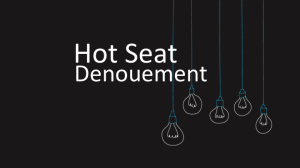Hot Seat #46 Denouement: 15 yo F w/ combativeness and AMS
Posted on: November 7, 2014, by : altered mental status
by Fareed Saleh, Children’s National
with Maybelle Kou, Inova Children’s Hospital
The Case
15 yo F p/w combativeness and altered mental status after playing field hockey outside on a hot day where she consumed copious amounts of water and Gatorade. This case offers a great review of how to approach a patient with AMS and how to treat an agitated patient.
Here’s How You Answered Our Questions
“Other” results from MORE than 3 yrs PEM = NS bolus, NS bolus and “rectal temp please post benzo.”
“Benzos, benzos, benzos….” The agitated AMS status patient should be treated differently than the agitated psych patient. If you don’t know what is causing the agitation, consider repeating benzos for agitation. If resulting respiratory depression, consider intubation early. Haldol should not be the first-line.
The patient is hyponatremic to 126. Some people wanted NS bolusing, others 3% hypertonic saline. Providers had different thresholds for giving 3% hypertonic saline. Some would give now as the patient is altered and has concerning VS (elevated bp & possible lowered HR). Others would wait until the sodium is lower or the patient is seizing (although Fareed stated that he couldn’t tell if the patient was seizing). Further, other providers would potentially give hypertonic saline after a Head CT to r/o other etiologies of AMS (e.g. a head bleed).
Denouement
Given that the patient continued to be combative, she had to be temporarily restrained by staff with midazolam (6 mg) administered. She was intubated with RSI (etomidate, rocuronium) for airway protection. Following intubation, CTH was done showing cerebral edema and mannitol plus hypertonic saline were given.
Other workup included an ECG showing RBBB w/prolonged QTc 480-500. Foley and NG tube were placed with urine toxicology sent. Pt was transferred to PICU for further care.
PICU stay was noted for repeat imaging (MRI Brain) that showed no signs of cerebral edema with pt extubated and returning to baseline on HD #3. Psychiatry and endocrinology consulted. Working diagnosis was hyponatremia 2/2 acute water intoxication.
Debrief Teaching Points – from Thursday Conference
Correcting hyponatremia highlights from Up to Date (Na in this patient was 126):
- Treatment approach depends on hemodynamic stability, hyponatremia severity and chronicity of hyponatremia.
- Seizures and altered mental status (occur typically with acute hyponatremia) require a more rapid approach using hypertonic saline and correction should not be delayed.
- Severe hyponatremia (typically <120 or 115 mEq/L): overly rapid correction of severe hyponatremia can lead to osmotic demyelination syndrome with irreversible neurologic damage. More often when the plasma sodium corrections >10 mEq/L in a 24-hour period.
- If seizures or AMS are attributable to hyponatremia, the plasma sodium should be raised until neurologic findings cease or the plasma sodium reaches 125 mEq/L.
- If seizing, acutely increase the plasma sodium by 3 to 5 mEq/L, typically with hypertonic saline. If continued seizures, repeat bolus.
- Evidence that hypertonic saline reduces intracranial pressure and improves cerebral edema.
- Otherwise, typically give hypertonic saline over 3 to 4 hours, at <3 mEq/L per hour.
- After the initial hypertonic saline infusion, measure sodium. Ongoing sodium correction is 6 and 8mEq/L daily (including the bolus given).
- If seizing, acutely increase the plasma sodium by 3 to 5 mEq/L, typically with hypertonic saline. If continued seizures, repeat bolus.
